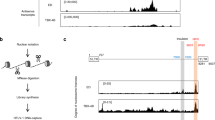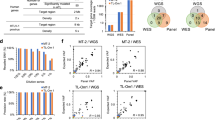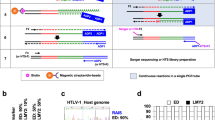Abstract
Although there is tight association of the human T-cell leukemia virus type-1 (HTLV-1) with adult T-cell leukemia/lymphoma (ATLL), it has remained unresolved whether the HTLV-1 integration into the host genome has any role in the development of this disease. We isolated a total of 58 HTLV-1 integration sites using newly developed, adaptor-ligated PCR from 33 ATLL patients and five ATLL cell lines. We compared our data as well as the previously reported ones with the complete human genomic sequence for the location of its placement, structure, and expression of genes nearby the integration site. The chromosomal target for integration was selected at random, but the integration favorably occurred within the transcription units; more than 59.5% of total integration was observed within the transcriptional unit. All inserted genes by HTLV-1 integration were expressed in normal T cells. Upregulation of genes due to viral integration was found in two out of nine ATLL cases; about 4.4- and 102-fold elevated ankyrin-1 (ANK-1) and gephyrin (GPHN) gene expressions were observed, respectively. These data suggest that the preferential integration of HTLV-1 into an expressed locus occasionally causes deregulation of corresponding gene, which may lead to leukemogenesis of a fraction of ATLL.
Similar content being viewed by others
Log in or create a free account to read this content
Gain free access to this article, as well as selected content from this journal and more on nature.com
or
References
Bamford RN, Battiata AP, Burton JD, Sharma H, Waldmann TA (1996) Interleukin (IL) 15/IL-T production by the adult T-cell leukemia cell line HuT-102 is associated with a human T-cell lymphotrophic virus type I region/IL-15 fusion message that lacks many upstream AUGs that normally attenuates IL-15 mRNA translation. Proc Natl Acad Sci USA 93:2897–902
Beretta L, Gingras AC, Svitkin YV, Hall MN, Sonenberg N (1996) Rapamycin blocks the phosphorylation of 4E-BP1 and inhibits cap-dependent initiation of translation. EMBO J 15:658–64
Brown EJ, Beal PA, Keith CT, Chen J, Shin TB, Schreiber SL (1995) Control of p70 s6 kinase by kinase activity of FRAP in vivo. Nature 377:441–6
Brunn GJ, Hudson CC, Sekulic A, Williams JM, Hosoi H, Houghton PJ, Lawrence JC Jr, Abraham RT (1997) Phosphorylation of the translational repressor PHAS-I by the mammalian target of rapamycin. Science 277:99–101
Bushman FD (2002) Integration site selection by lentiviruses: biology and possible control. Curr Top Microbiol Immunol 261:165–77
Chi KD, McPhee RA, Wagner AS, Dietz JJ, Pantazis P, Goustin AS (1997) Integration of proviral DNA into the PDGF beta-receptor gene in HTLV-I-infected T cells results in a novel tyrosine kinase product with transforming activity. Oncogene 15:1051–7
Chung J, Kuo CJ, Crabtree GR, Blenis J (1992) Rapamycin-FKBP specifically blocks growth-dependent activation of and signaling by the 70 kd S6 protein kinases. Cell 69:1227–36
Eguchi M, Eguchi-Ishimae M, Seto M, Morishita K, Suzuki K, Ueda R, Ueda K, Kamada N, Greaves M (2001) GPHN, a novel partner gene fused to MLL in a leukemia with t(11;14)(q23;q24). Genes Chromosomes Cancer 32:212–21
Hata T, Fujimoto T, Tsushima H, Murata K, Tsukasaki K, Atogami S, Sohda H, Honda S, Mine M, Yamada Y et al (1999) Multi-clonal expansion of unique human T-lymphotropic virus type-I-infected T cells with high growth potential in response to interleukin-2 in prodromal phase of adult T-cell leukemia. Leukemia 13:215–21
Hinuma Y, Nagata K, Hanaoka M, Nakai M, Matsumoto T, Kinoshita KI, Shirakawa S, Miyoshi I (1981) Adult T-cell leukemia: antigen in an ATL cell line and detection of antibodies to the antigen in human sera. Proc Natl Acad Sci USA 78:6476–80
Holmes-Son ML, Appa RS, Chow SA (2001) Molecular genetics and target site specificity of retroviral integration. Adv Genet 43:33–69
Ji H, Moore DP, Blomberg MA, Braiterman LT, Voytas DF, Natsoulis G, Boeke JD (1993) Hotspots for unselected Ty1 transposition events on yeast chromosome III are near tRNA genes and LTR sequences. Cell 73:1007–18
Jonkers J, Berns A (1996) Retroviral insertional mutagenesis as a strategy to identify cancer genes. Biochim Biophys Acta 1287:29–57
Kirchner J, Connolly CM, Sandmeyer SB (1995) Requirement of RNA polymerase III transcription factors for in vitro position-specific integration of a retrovirus like element. Science 267:1488–91
Kirsch J, Betz H (1995) The postsynaptic localization of the glycine receptor-associated protein gephyrin is regulated by the cytoskeleton. J Neurosci 15:4148–56
Kirsch J, Langosch D, Prior P, Littauer UZ, Schmitt B, Betz H (1991) The 93-kDa glycine receptor-associated protein binds to tubulin. J Biol Chem 266:22242–5
Korber B, Okayama A, Donnelly R, Tachibana N, Essex M (1991) Polymerase chain reaction analysis of defective human T-cell leukemia virus type I proviral genomes in leukemic cells of patients with adult T-cell leukemia. J Virol 65:5471–6
Kubota S, Siomi H, Hatanaka M, Pomerantz RJ (1996) Cis/trans-activation of the interleukin-9 receptor gene in an HTLV-I-transformed human lymphocytic cell. Oncogene 12:1441–7
Kuo CJ, Chung J, Fiorentino DF, Flanagan WM, Blenis J, Crabtree GR (1992) Rapamycin selectively inhibits interleukin-2 activation of p70 S6 kinase. Nature 358:70–3
Kuwada N, Kimura F, Matsumura T, Yamashita T, Nakamura Y, Wakimoto N, Ikeda T, Sato K, Motoyoshi K (2001) t(11;14)(q23;q24) generates an MLL-human gephyrin fusion gene along with a de facto truncated MLL in acute monoblastic leukemia. Cancer Res 61:2665–9
Lander ES, Linton LM, Birren B, Nusbaum C, Zody MC, Baldwin J, Devon K, Dewar K, Doyle M, FitzHugh W et al (2001) Initial sequencing and analysis of the human genome. Nature 409:860–921
Leclercq I, Mortreux F, Cavrois M, Leroy A, Gessain A, Wain-Hobson S, Wattel E (2000) Host sequences flanking the human T-cell leukemia virus type 1 provirus in vivo. J Virol 74:2305–12
Macera MJ, Szabo P, Verma RS (1992) Chromosomal localization of HTLV-1 viral integration sites using in situ hybridization: detection of a novel IL2R fragment. Mol Gen Genet 234:466–74
Maeda T, Yamada Y, Moriuchi R, Sugahara K, Tsuruda K, Joh T, Atogami S, Tsukasaki K, Tomonaga M, Kamihira S (1999) Fas gene mutation in the progression of adult T-cell leukemia. J Exp Med 189:1063–71
von Manteuffel SR, Gingras AC, Ming XF, Sonenberg N, Thomas G (1996) 4E-BP1 phosphorylation is mediated by the FRAP-p70s6k pathway and is independent of mitogen-activated protein kinase. Proc Natl Acad Sci USA 93:4076–80
Naoe T, Akao Y, Yamada K, Utsumi KR, Koike K, Shamoto M, Koie K, Kurosawa Y, Kato K, Abe M et al (1988) Cytogenetic characterization of a T-cell line, ATN-1, derived from adult T-cell leukemia cells. Cancer Genet Cytogenet 34:77–88
Ochman H, Gerber AS, Hartl DL (1988) Genetic applications of an inverse polymerase chain reaction. Genetics 120:621–3
Ohshima K, Kikuchi M, Masuda Y, Kobari S, Sumiyoshi Y, Eguchi F, Mohtai H, Yoshida T, Takeshita M, Kimura N (1991) Defective provirus form of human T-cell leukemia virus type I in adult T-cell leukemia/lymphoma: clinicopathological features. Cancer Res 51:4639–42
Ohshima K, Ohgami A, Matsuoka M, Etoh K, Utsunomiya A, Makino T, Ishiguro M, Suzumiya J, Kikuchi M (1998) Random integration of HTLV-1 provirus: increasing chromosomal instability. Cancer Lett 132:203–12
Park DJ, Pask AJ, Renfree MB, Graves JA (2003) 3′ RACE walking along a large cDNA employing tiered suppression PCR. Biotechniques 34:750–2, 754–6
Poiesz BJ, Ruscetti FW, Gazdar AF, Bunn PA, Minna JD, Gallo RC (1980) Detection and isolation of type C retrovirus particles from fresh and cultured lymphocytes of a patient with cutaneous T-cell lymphoma. Proc Natl Acad Sci USA 77:7415–9
Prior P, Schmitt B, Grenningloh G, Pribilla I, Multhaup G, Beyreuther K, Maulet Y, Werner P, Langosch D, Kirsch J et al (1992) Primary structure and alternative splice variants of gephyrin, a putative glycine receptor-tubulin linker protein. Neuron 8:1161–70
Richardson JH, Rose NJ, Mann S, Ferguson-Smith M, Lever AM (2001) Chromosomal positioning of human T-lymphotropic type 1 proviruses by fluorescence in situ hybridisation. J Virol Meth 93:65–74
Sabatini DM, Barrow RK, Blackshaw S, Burnett PE, Lai MM, Field ME, Bahr BA, Kirsch J, Betz H, Snyder SH (1999) Interaction of RAFT1 with gephyrin required for rapamycin-sensitive signaling. Science 284:1161–4
Schroder AR, Shinn P, Chen H, Berry C, Ecker JR, Bushman F (2002) HIV-1 integration in the human genome favors active genes and local hotspots. Cell 110:521–9
Seiki M, Hattori S, Yoshida M (1982) Human adult T-cell leukemia virus: molecular cloning of the provirus DNA and the unique terminal structure. Proc Natl Acad Sci USA 79:6899–902
Seiki M, Eddy R, Shows TB, Yoshida M (1984) Nonspecific integration of the HTLV provirus genome into adult T-cell leukaemia cells. Nature 309:640–2
Shimoyama M (1991) Diagnostic criteria and classification of clinical subtypes of adult T-cell leukaemia-lymphoma. A report from the Lymphoma Study Group (1984–87). Br J Haematol 79:428–37
Siebert PD, Chenchik A, Kellogg DE, Lukyanov KA, Lukyanov SA (1995) An improved PCR method for walking in uncloned genomic DNA. Nucl Acids Res 23:1087–8
Smith DR (1992) Ligation-mediated PCR of restriction fragments from large DNA molecules. PCR Meth Appl 2:21–7
Venter JC, Adams MD, Myers EW, Li PW, Mural RJ, Sutton GG, Smith HO, Yandell M, Evans CA, Holt RA et al (2001) The sequence of the human genome. Science 291:1304–51
Watanabe T, Seiki M, Yoshida M (1984) HTLV type I (US isolate) and ATLV (Japanese isolate) are the same species of human retrovirus. Virology 133:238–41
Yamada Y, Nagata Y, Kamihira S, Tagawa M, Ichimaru M, Tomonaga M, Shiku H (1991) IL-2-dependent ATL cell lines with phenotypes differing from the original leukemia cells. Leuk Res 15:619–25
Yamada Y, Sugahara K, Tsuruda K, Nohda K, Hata T, Maeda T, Honda M, Tawara M, Hayashibara T, Joh T et al (1999) Fas-resistance in ATL cell lines not associated with HTLV-I or FAP-1 production. Cancer Lett 147:215–9
Yoshida M (1983) Identification of adult T-cell leukemia virus and its gene structure. Gan To Kagaku Ryoho 10:680–9
Yoshida M, Seiki M, Yamaguchi K, Takatsuki K (1984) Monoclonal integration of human T-cell leukemia provirus in all primary tumors of adult T-cell leukemia suggests causative role of human T-cell leukemia virus in the disease. Proc Natl Acad Sci USA 81:2534–7
Acknowledgments
We thank Mr. Shawkat Haider for correction of English and critical reading of manuscript. This research was partially supported by a grant-in-aid for Scientific Research from the Ministry of Education, Science, Sports, and Culture of Japan.
Author information
Authors and Affiliations
Corresponding author
Rights and permissions
About this article
Cite this article
Ozawa, T., Itoyama, T., Sadamori, N. et al. Rapid isolation of viral integration site reveals frequent integration of HTLV-1 into expressed loci. J Hum Genet 49, 154–165 (2004). https://doi.org/10.1007/s10038-004-0126-7
Received:
Accepted:
Published:
Issue date:
DOI: https://doi.org/10.1007/s10038-004-0126-7
Keywords
This article is cited by
-
Genome-wide target profiling of piggyBac and Tol2in HEK 293: pros and cons for gene discovery and gene therapy
BMC Biotechnology (2011)
-
TCR variable gene involvement in chromosome inversion between 14q11 and 14q24 in adult T-cell leukemia
Journal of Human Genetics (2006)
-
Matrix attachment regions as targets for retroviral integration
Virology Journal (2005)



